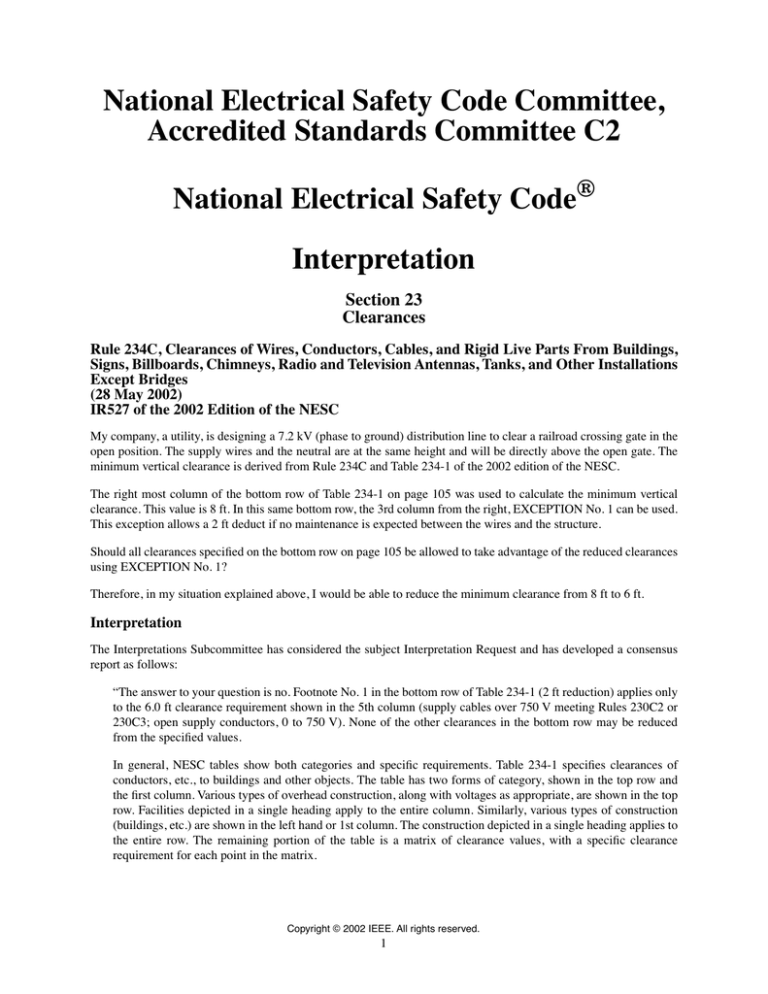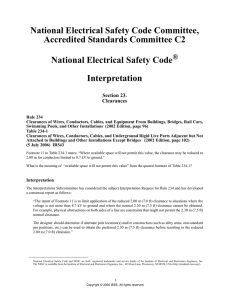
National Electrical Safety Code Committee,
Accredited Standards Committee C2
National Electrical Safety Code®
Interpretation
Section 23
Clearances
Rule 234C, Clearances of Wires, Conductors, Cables, and Rigid Live Parts From Buildings,
Signs, Billboards, Chimneys, Radio and Television Antennas, Tanks, and Other Installations
Except Bridges
(28 May 2002)
IR527 of the 2002 Edition of the NESC
My company, a utility, is designing a 7.2 kV (phase to ground) distribution line to clear a railroad crossing gate in the
open position. The supply wires and the neutral are at the same height and will be directly above the open gate. The
minimum vertical clearance is derived from Rule 234C and Table 234-1 of the 2002 edition of the NESC.
The right most column of the bottom row of Table 234-1 on page 105 was used to calculate the minimum vertical
clearance. This value is 8 ft. In this same bottom row, the 3rd column from the right, EXCEPTION No. 1 can be used.
This exception allows a 2 ft deduct if no maintenance is expected between the wires and the structure.
Should all clearances specified on the bottom row on page 105 be allowed to take advantage of the reduced clearances
using EXCEPTION No. 1?
Therefore, in my situation explained above, I would be able to reduce the minimum clearance from 8 ft to 6 ft.
Interpretation
The Interpretations Subcommittee has considered the subject Interpretation Request and has developed a consensus
report as follows:
“The answer to your question is no. Footnote No. 1 in the bottom row of Table 234-1 (2 ft reduction) applies only
to the 6.0 ft clearance requirement shown in the 5th column (supply cables over 750 V meeting Rules 230C2 or
230C3; open supply conductors, 0 to 750 V). None of the other clearances in the bottom row may be reduced
from the specified values.
In general, NESC tables show both categories and specific requirements. Table 234-1 specifies clearances of
conductors, etc., to buildings and other objects. The table has two forms of category, shown in the top row and
the first column. Various types of overhead construction, along with voltages as appropriate, are shown in the top
row. Facilities depicted in a single heading apply to the entire column. Similarly, various types of construction
(buildings, etc.) are shown in the left hand or 1st column. The construction depicted in a single heading applies to
the entire row. The remaining portion of the table is a matrix of clearance values, with a specific clearance
requirement for each point in the matrix.
Copyright © 2002 IEEE. All rights reserved.
1
NATIONAL ELECTRICAL SAFETY CODE—INTERPRETATION
Again using Table 234-1 as an example, Footnote No. 5 and Footnote No. 13 appear in the heading of Column 2.
Footnote No. 5, covering supply cables meeting Rule 230C1, applies to the entire column; Footnote No. 13,
covering ungrounded guys exposed to 0 to 300 V, also applies to the entire column. Similarly, Footnote No. 4 in
the heading of the bottom row (first or left column) applies to the entire row.
Conversely, Footnote No. 1 appears at many points in the matrix. In the third from the bottom row [Item a(2)],
Footnote No. 1 appears in the 4th, 5th, 6th, and 7th columns and, in this row, applies only to these clearance
values. Footnote No. 1 does not apply to the clearances in the 2nd and 3rd columns of this row.
In summary, Footnote No. 1 does not apply to the 8 ft clearance requirement shown in the last column of the
bottom row.”
Copyright © 2002 IEEE. All rights reserved.
2




